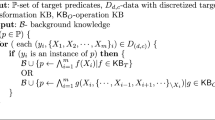Abstract
Knowledge representation has always been a major problem in the design of medical decision support systems. In this paper we present a new methodology to represent and reason about medical knowledge, based on the declarative specification of interval constraints over the medical concepts. This allows the integration of deep medical models involving differential equations developed in biomedical research (typical in several medical domains) which, to their complexity, have not been incorporated into medical decision support systems. The methodology which enables reasoning both forward and backward in time, is applied to a specific domain, electromyography. The promising results obtained are discussed to justify our future work.
Access this chapter
Tax calculation will be finalised at checkout
Purchases are for personal use only
Preview
Unable to display preview. Download preview PDF.
Similar content being viewed by others
References
O'Neil, M., Glowinski, A. and Fox, J.: A Symbolic Theory of Decision Making Applied to Several Medical Tasks, Lecture Notes in Medical Informatics, Springer, 38 (1989) 62–71.
Horn, W.: Utilizing Detailed Anatomical Knowledge for Hypothesis Formation and Hypothesis Testing in Rheumatological Decision Support. In: E. Keravnou, eds., Deep Models for Medical Knowledge Engineering, Elsevier, (1992) 27–50.
Cruz, J. and Barahona, P.: A Causal-Functional Model Applied to EMG Diagnosis, Proceedings of the 6th Conference on Artificial Intelligence in Medicine Europe, AIME'97, Springer, Grenoble, France (1997) 249–260.
Andreassen, S., Falck, B. and Olesen, K.G.: Diagnostic Function of the Microhuman Prototype of the Expert System MUNIN, Electroencephalography and Clinical Neurophysiology 85 (1992) 143–157.
Suojanen, M., Olesen, K.G. and Andreassen, S.: A Method for Diagnosing in Large Medical Expert Systems Based on Causal Probabilistic Networks, Proceedings of the 6th Conference on Artificial Intelligence in Medicine Europe, AIME'97, Springer, Grenoble, France (1997) 285–295.
Timmons, W.D.: Cardiovascular Models and Control. In: The Biomedical Engineering Handbook. CRC/IEEE Press, Connecticut (1995) 2386–2403.
Poon, C.-S.: Respiratory Models and Control. In: The Biomedical Engineering Handbook. CRC/IEEE Press, Connecticut (1995) 2404–2421.
Cobelli, C. and Saccomani, M.P.: Compartment Models of Physiologic Systems. In: The Biomedical Engineering Handbook. CRC/IEEE Press, Connecticut (1995) 2375–2385.
Aminoff M.J.: Electrodiagnosis in Clinical Neurology. 3th edn. Churchill Livingstone, New York (1992).
FitzHugh, R.: Mathematical models of excitation and propagation in nerve. In: Biological Engineering, chap I, McGraw-Hill, New York (1969) 1–85.
Tasaki, I.: Conduction of the Nerve Impulse. In: Handbook of Physiology, section I: Neurophysiology Vol. I. American Physiological Society, Washington (1959) 75–121.
Van Denneheuvel, S et al: Reduced Constraint Models. In: E. Keravnou, eds., Deep Models for Medical Knowledge Engineering, Elsevier, (1992) 89–100.
Cleary J.G.: Logical Arithmetic. In Future Generation Computing Systems, 2(2) (1987) 125–149.
Moore R.E.: Interval Analysis. Prentice-Hall, Englewood Cliffs, NJ (1966).
Benhamou, F., McAllester, D. and Van Hentenryck, P.: CLP(intervals) revisited. In Proceedings of the International Logic Programming Symposium (1994).
Haroud, D. and Faltings, B.: Consistency techniques for continuous constraints. In Constraints 1(1 and 2) (1996) 85–118.
Hartman, P.: Ordinary Differential Equations. Wiley, New York (1964).
Older, W.: Application of Relational Interval Arithmetic to Ordinary Differential Equations, in Workshop on Constraint Languages and their use in Problem Modelling, Int'l Logic Programming Symposium, Ithaca, New York (1994).
Deville, Y., Janssen, M. and Van Hentenryck, P.: Consistency Techniques in Ordinary Differential Equations. In: Proceedings of the 4th International Conference on Principles and Practice of Constraint Programming-CP98. Pisa, Italy (1998) 162–176.
Veloso, M. et al, ESTEEM: European Standardized Telematics Tool to Evaluate EMG Knowledge Based Systems and Methods, in Health in the New Communication Age, Laires, M.F., Ladeira, M.J. and Christensen, J.P. (Eds.), IOS Press, pp. 348–356, 1995
Author information
Authors and Affiliations
Editor information
Editors and Affiliations
Rights and permissions
Copyright information
© 1999 Springer-Verlag Berlin Heidelberg
About this paper
Cite this paper
Cruz, J., Barahona, P., Benhamou, F. (1999). Integrating Deep Biomedical Models into Medical Decision Support Systems: An Interval Constraint Approach. In: Horn, W., Shahar, Y., Lindberg, G., Andreassen, S., Wyatt, J. (eds) Artificial Intelligence in Medicine. AIMDM 1999. Lecture Notes in Computer Science(), vol 1620. Springer, Berlin, Heidelberg. https://doi.org/10.1007/3-540-48720-4_20
Download citation
DOI: https://doi.org/10.1007/3-540-48720-4_20
Published:
Publisher Name: Springer, Berlin, Heidelberg
Print ISBN: 978-3-540-66162-7
Online ISBN: 978-3-540-48720-3
eBook Packages: Springer Book Archive




